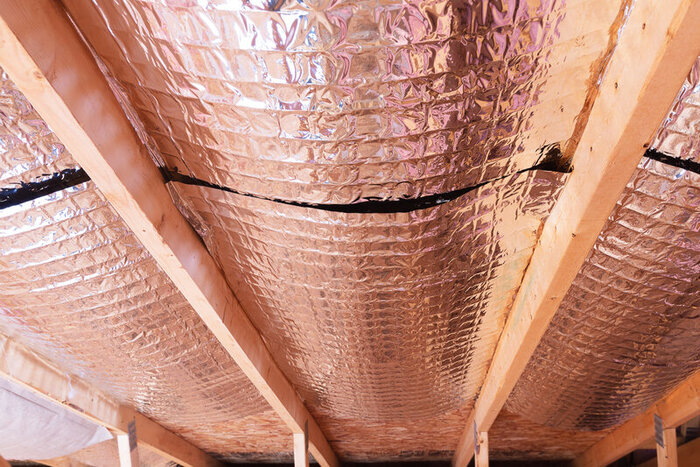
Your attic is a key player when it comes to whole-home comfort and energy efficiency. The combination of your roof system, adequate attic design and insulation, and ventilation work together to keep conditioned air inside and regulate temperatures, so they don’t vary much from your preferred thermostat settings.
Our last post discussed the importance of using a moisture or vapor barrier in your crawl spaces. In this post, we discuss radiant barrier basics.
Where vapor barriers work to mitigate the amount of moisture that makes its way into the home, causing interior moisture and humidity issues, radiant barriers protect your home from solar heat gain. According to the U.S. Department of Energy, your attic can reach temperatures of up to 150 degrees Fahrenheit if you don’t have a proper roof and attic design.
The term, Hot, is an understatement, and all that heat travels right through walls and into your living spaces, causing your HVAC to work overtime to maintain the cooler desired temperatures set on your thermostat. Installing radiant heat barriers reflects solar heat gain rather than absorbs it, keeping it out of your home altogether.
According to the U.S. Department of Energy:
When the sun heats a roof, it's primarily the sun's radiant energy that makes the roof hot. Much of this heat travels by conduction through the roofing materials to the attic side of the roof. The hot roof material then radiates its gained heat energy onto the cooler attic surfaces, including the air ducts and the attic floor. A radiant barrier reduces the radiant heat transfer from the underside of the roof to the other surfaces in the attic.
Again, the U.S. Department of Energy says that radiant barriers in the attic reduce solar geat gain from the roof by as much as 40%. This can add up to a 17% savings in cooling costs during the warmest parts of the year. Go through your previous utility bills and do some basic math to get an idea of how much you’ll save, and then multiply that by the number of years you plan to stay in your home.
For example, experts say that heating/cooling accounts for about 50% of your utility costs. Review the bills from the warm months of the year and divide them in half. Then multiply that amount by 17%. That shows you how much you’ll save per year. Odds are, a radiant barrier will pay for itself within ten years.
Also, remember that energy-efficient features, such as a new roof, insulation, and radiant barriers, increase resale value because energy efficiency is a top priority for today’s home buyers.
There are several different types of radiant barriers to choose from. Your licensed insulation contractor will help you determine which one is right for your goals and with your current insulation. If you are in the process of replacing outdated insulation, this is a perfect opportunity to discuss the addition of a radiant barrier to increase attic efficiency exponentially.
There are two different types of radiant barriers:
An unperforated radiant barrier works as a vapor barrier because it doesn’t allow any condensation or moisture to pass through it. This is ideal in a crawl space, where you want to keep ground moisture from transferring into your home. However, in an attic, this isn’t the best idea. Unperforated vapor barriers in an attic may create condensation on the inside surface of the attic, which drips down onto the insulation and the attic floors. Over time, this leads to humidity issues as well as the potential for mold and mildew damage.
As the name implies, perforated barriers have a series of holes that allow moisture vapor to travel back and forth without allowing radiant heat in. Therefore, we almost always recommend installing perforated radiant barriers in the attic, where the hot/cold surfaces of the barrier alternate depending on the season.
Installing a perforated barrier eliminates some of the most common things that can go wrong with radiant barriers, including moisture issues or heat issues that compromise roof performance.
Proper installation of a radiant barrier is essential to ensure it performs as advertised. But, as we’ve mentioned before, the attic is part of a system that includes roofing materials, insulation adequacy, and ventilation. Therefore, an issue in any one of those departments negatively impacts radiant barrier performance.
To get the most from a radiant barrier in the attic, you must also optimize your home’s roof, insulation, and ventilation systems. In our post, How to Prepare for Attic Insulation, we discuss completing any necessary roof repairs and ensuring your home is properly air sealed and ventilated. You can install the world’s greatest radiant barrier or insulation, but it can never perform at its best if the other parts of the system need help.
If your roof is ten years old or more, this is a great time to schedule a professional roof inspection. Making the necessary updates and repairs on the roof and ensuring its well-ventilated supports and protects your attic improvement investments.
Would you like to learn more about radiant barriers or determine whether a radiant barrier installation is worth it for your Bay Area home? Contact us here at Attic Solutions, (510) 500-5007, and schedule a consultation. We’ll answer your questions and provide a free, no-obligation quote if we feel a radiant barrier is a good idea. We can also put you in touch with some of the area’s most reputable roofing contractors if needed.